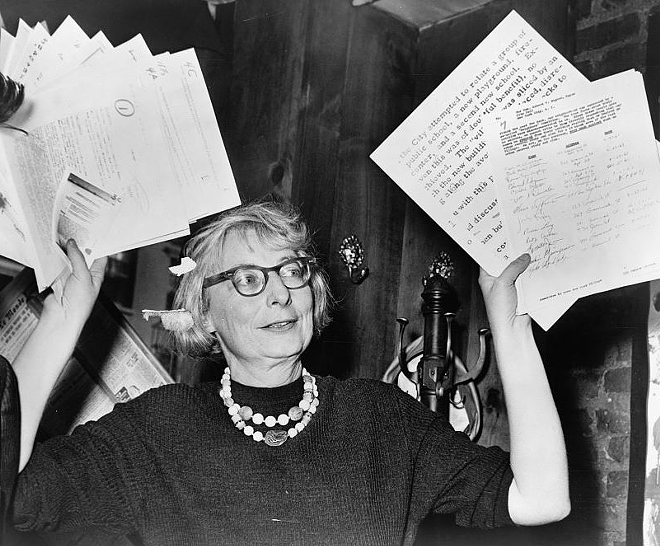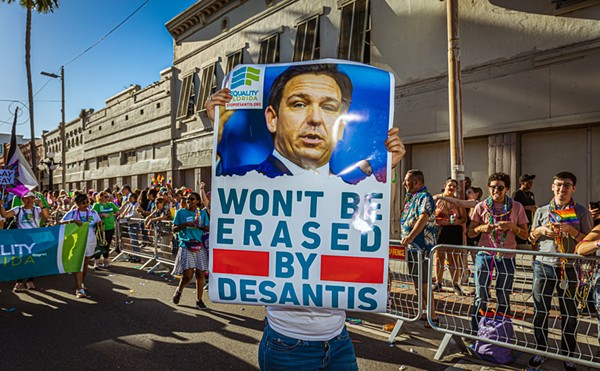
Jane Jacobs kicked ass. As a journalist, activist and urban pioneer she stood up to Robert Moses, the second most powerful man in America, and fought successfully to save her neighborhood.
Citizen Jane: Battle for the City, a new documentary about this dynamic woman, screens Wednesday night, June 7, at 7:30 at the Tampa Theatre, and it’s a must-see.
The Tampa Downtown Partnership, the screening’s sponsor, is offering a free Jane’s Walk tour of Tampa’s urban core at 5:30 (meet under the Tampa Theatre marquee) and at 7:15 there’s a Jane Jacobs look-alike contest, costumes encouraged.
Jacobs’s book The Life and Death of Great American Cities has long been considered the bible for urban redevelopment. She’s a hero of urban planners and historic preservationists. How did this individual successfully protect her home turf, and why is this important for Tampa Bay?
Jacobs’s professional life began as a journalist, so she understood the power of a good story. When her neighborhood, New York City’s West Greenwich Village, was threatened with demolition by Moses’s public-works projects, she sprang into action.
Moses, New York City’s Commissioner for Parks, director of NYC’s Housing Authority and Triborough Bridge Authority, was considered by many to be unstoppable by either New York’s mayor or governor.
Robert Caro’s Pulitzer Prize-winning bio of Moses, The Power Broker, describes his evolution from an idealistic planner bent on improving the lives of regular folks to a maniacal mover and shaker who delighted in reshaping the city to support suburban development.
Moses was biased in favor of roads and cars, rather than transit. He planned to put a roadway through the center of Washington Square and mow down blocks of townhouses.
When Moses disparaged his critics as “just a bunch of housewives,” Jacobs cleverly rallied her neighbors, who were aghast at the proposed destruction of their park. She pulled together dozens of women with baby carriages who gathered at the base of the Washington Square Arch and provided a powerful photo op for the cause.
The neighbors packed public meetings and raised hell. They were able to convince their council members and ultimately the mayor to support them, and the project was stymied — a victory for grass-roots opposition.
A second Moses project would prove to be his Waterloo, thanks to opposition led by Jacobs.
As part of the proposed Lower Manhattan Expressway, he wanted to demolish many of the old buildings in SoHo and Little Italy, destroying the world’s largest collection of cast-iron mid-rises.
But Jacobs was an advocate for “messy street life.” She observed that the tight living conditions of tenements, while certainly not ideal, meant that older folks kept an eye on the younger ones who played in front of their stoops. “Over 50 years ago, Jane was thinking about these attributes and how they contribute to everyday city life,” observes Melissa Dickens, president-elect of the American Planning Association of Florida. ”She revolutionized the entire planning profession, through simple observations about the ways in which cities function.”
Cleverly, Jacobs appropriated the symbol for buildings targeted for demolition, masking-tape crosses on the windows, to her cause. Her supporters arrived at public meetings with white crosses on their glasses, again creating a memorable visual for the press.
Moses was flummoxed. Although he had destroyed swaths of Brooklyn, Queens and Harlem with his 28,000 units of public housing, Jacbos and her group stopped him in Lower Manhattan. This second defeat turned the tide of public opinion against Moses and checked his power.
Jacbos sallied on as a writer and activist, moving to Canada to protect her sons from the draft during the Vietnam War. She weighed in on the development of Toronto, helping shape it into the livable, walkable place it is today.
So why is this film relevant to Tampa Bay? In my opinion, some of our politicians, certainly Rick Scott, manifest Robert Moses-like penchants for serving suburbanites by providing more roads, at the expense of existing urban neighborhoods. Moses absolutely disrespected older communities and had no taste for history.
Kudos to all the professional organizations — the American Institute of Architects Tampa Bay, American Society of Landscape Architects, Congress for New Urbanism, Urban Land Institute and the American Planning Association — for working with the Tampa Downtown Partnership to promote this film and speak on a panel following the film.
Stephen Benson, representing the Congress for New Urbanism, observes that well-designed cities, towns, neighborhoods and public places help create community: healthy places for people and businesses to thrive and prosper.
CNU views disinvestment in central cities, the spread of placeless sprawl, increasing separation by race and income, environmental deterioration, loss of agricultural lands and wilderness, and the erosion of society’s built heritage as one interrelated community-building challenge.
“Jane Jacobs is without a doubt the most influential writer on urban planning in modern times. She was the first true whistle-blower on the great mistakes of post-war suburbanization, and the principles in the CNU Charter are rooted in the ideals and prophecies she first articulated in The Death and Life of Great American Cities,” says Benson.
It’s so refreshing to watch a documentary about urban conflict where the good guys win. And the Tampa Theatre, whose fate was determined by a 4-3 vote by Tampa City Council in 1973, is the perfect venue to celebrate grass-roots success.
Linda Saul-Sena served on the Tampa City Council from 1987-2010, and is a member of the board of Tampa Theatre.

















